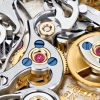-
Recently Browsing
- No registered users viewing this page.
-
Topics
-
Posts
-
Unfortunately yes! Magnetism can wreak havoc on a mechanical watch movement if the balance hairspring becomes magnetised. The cheap blue Chinese demagnetise-rs are useless if you feed them the wrong voltage (> 110 V), and even so, they don't work very well. The one I got when I was new worked so poorly that it drove me nuts. Eventually, I was lucky to get a Greiner Magnomatic for a little money. It's an amazing tool that can be trusted to do its job perfectly in seconds. A new one comes with a price tag of £885 excluding tax and shipping, and if you think that's a bit steep (I believe most of us would) and can't find a used one I'd go with @Jon's recommendation.
-
By Neverenoughwatches · Posted
Yep Mike , i use exactly the same gauge for it. -
By Neverenoughwatches · Posted
You definitely pick up different names from different people of all ages from everywhere. Like learning different dialects of the same language. Its all part of the learning curve of any trade. Both those two terms describe to me perfectly that they are one and the same. After a couple of years of knowledge you can figure out what is being talked about. There are times that i get caught out with something i haven't encountered before. -
Mike, you have summed it up following the KISS principle. Tom
-
I think this is pretty typical when you have something that crosses many regional and international borders. @Neverenoughwatches yes Rich, that is the common way, learning from our teachers, however terms used in Yorkshire could easily be a lot different for tools, techniques or methods different from Scotland or Somerset. My (long winded) point is it all depends on where you first picked up the terms, if from books American watch terminology differs from English terminology and to a degree Swiss terminology. That also seems to extend to watchmaking schools. Confusing at first starting out but like anything else you get used to it. This will be why our long term members attach a glossary to new users introducing themselves as beginning their journey. Tom
-









Recommended Posts